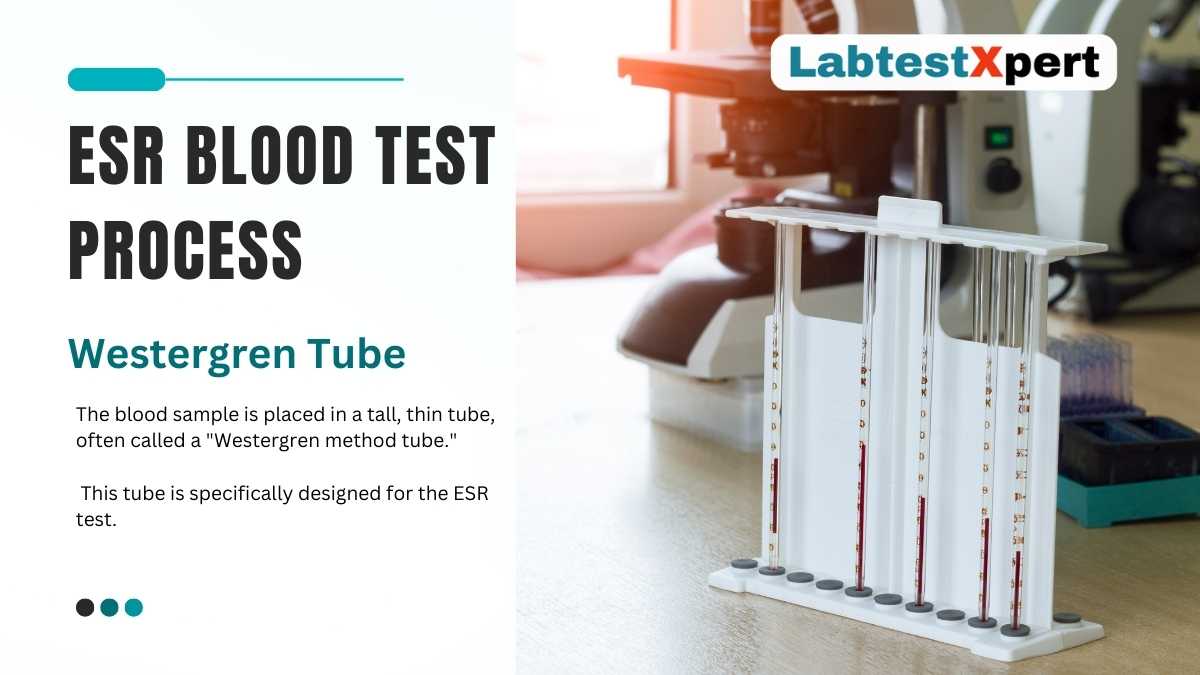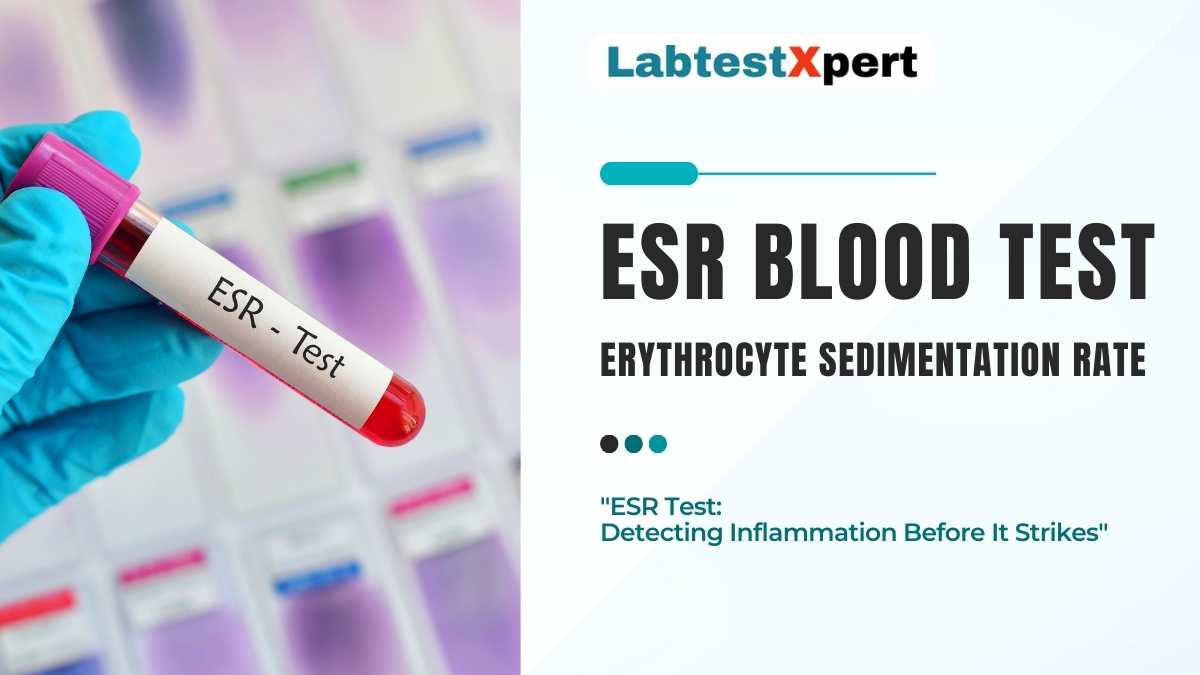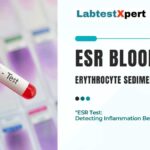The ESR blood test, or Erythrocyte Sedimentation Rate test, is a common blood test used in medicine to assess and monitor inflammation in the body. It’s a simple yet valuable tool that can provide healthcare professionals with important information about a patient’s health
What is the ESR blood Test, and Why Is It Essential?
The ESR (Erythrocyte Sedimentation Rate) test is a common blood test that measures the rate at which red blood cells (erythrocytes) settle to the bottom of a tube over a specific period of time, usually one hour. It is an important diagnostic tool used in medicine for the following reasons:
- Assessing Inflammation:
The ESR test is primarily used to assess the degree of inflammation in the body. When inflammation is present, certain proteins in the blood can cause red blood cells to clump together, making them heavier and causing them to settle more quickly. An elevated ESR value often indicates increased inflammation.
- Monitoring Disease Activity:
The ESR test is commonly used to monitor the progression and activity of various diseases, such as autoimmune disorders, inflammatory conditions, and infections. Changes in ESR values over time can help healthcare providers determine the effectiveness of treatment and whether a condition is improving or worsening.
- Diagnosing Inflammatory Conditions:
ESR is a valuable tool in the diagnosis of conditions like rheumatoid arthritis, systemic lupus erythematosus (SLE), and temporal arteritis, among others. Elevated ESR levels can be a marker of these conditions.
- Detecting Infections:
During infections, the ESR can increase due to the body’s inflammatory response to pathogens. It can be used as a complementary diagnostic tool for infectious diseases.
- Identifying Underlying Health Issues:
An abnormal ESR result can prompt further investigation to identify the underlying cause of inflammation, which may lead to a more accurate diagnosis.
- Monitoring the Effect of Medications:
For certain diseases, such as rheumatoid arthritis, ESR is used to assess the response to medications. A reduction in ESR values can indicate that treatment is effective in managing the condition.
- Guiding Treatment Decisions:
In cases of multiple myeloma or lymphomas, ESR values can be used to help make decisions about treatment and monitor the progress of these diseases.
How Does the ESR blood Test Process?
- Blood Sample:
A small amount of your blood is collected , typically from a vein in your arm. This sample is then placed in a EDTA tube for the test.

- Westergren Tube:
The blood sample is placed in a tall, thin tube, often called a “Westergren tube” or “Westergren method tube.” This tube is specifically designed for the ESR test.
- Anti-Coagulant:
An anticoagulant is usually added to the blood sample to prevent it from clotting during the test. This ensures that the red blood cells can settle in the tube without clumping together.
- Vertical Position:
The Westergren tube is placed in a vertical position and left undisturbed for a specific period, commonly one hour.
- Measurement:
The ESR test measures the distance (in millimeters) that the red blood cells have settled within the tube over the course of the designated time, which is one hour. The result is reported in millimeters per hour (mm/hr).
- Results:
The ESR value indicates how quickly or slowly the red blood cells settle. A higher value typically suggests increased inflammation, while a lower value suggests less inflammation.
The ESR test is a simple yet valuable tool for assessing inflammation in the body, but it is not a diagnostic test on its own. Instead, it serves as an indicator that prompts further investigation to determine the underlying cause of inflammation. When interpreting ESR test results, healthcare providers consider the patient’s medical history, symptoms, and other diagnostic tests to arrive at a more accurate diagnosis.
Alternate name of ESR Blood test?
ESR full form is commonly known as” Erythrocyte Sedimentation Rate”, which is widely used in healthcare sector. Erythrocyte Sedimentation Rate test, is often referred to by an alternative name ”ESR”, which is “sed rate” or “erythrocyte sedimentation rate.” These terms are commonly used in clinical settings and medical discussions as shorter.
Sample Required for ESR blood tests?
The ESR (Erythrocyte Sedimentation Rate) test typically requires a blood sample collected in a specialized tube, and it does not usually require fasting. Here are the details regarding the type of tube, sample volume, fasting requirements, and preparation for the ESR test:
- Type of Tube:
This is a specific type of tube that is used for the test. ESR blood sample collected in EDTA sample tube.
- Sample Volume:
The amount of blood needed for the ESR test is relatively small, typically about 1ml or 2 ml. A single blood collection tube is usually sufficient to obtain this volume.
- Fasting Requirements:
In most cases, fasting is not required for the ESR test. It is considered a non-fasting test, meaning that you do not need to abstain from food or drink before having the test done. However, it’s essential to follow any specific instructions provided by your healthcare provider or the laboratory where the test will be performed.
- Preparation for ESR test:
There is minimal preparation required for the ESR test. Below are some general guidelines to consider:
- Inform your healthcare provider about any medications or supplements you are taking, as certain drugs can affect ESR results.
- It’s essential to stay well-hydrated before the test. Being well-hydrated can help ensure that the blood sample is of good quality and flows more easily.
- Relax and remain calm during the blood collection process to minimize stress and potential effects on the results.
- Follow any specific instructions provided by your healthcare provider or the laboratory where the test will be performed.
ESR test price or charges:
The cost of an ESR (Erythrocyte Sedimentation Rate) test in India can vary depending on the location; Always verify the current rates with the specific facility or lab where you plan to have the test done.
| State (City Name) | Approximate ESR test price in India |
| Delhi | ₹150 – ₹500 INR |
| Mumbai, Maharashtra | ₹150 – ₹400 INR |
| Bangalore, Karnataka | ₹150 – ₹400 INR |
| Chennai, Tamil Nadu | ₹100 – ₹350 INR |
| Kolkata, West Bengal | ₹150 – ₹400 INR |
| Hyderabad, Telangana | ₹150 – ₹400 INR |
| Pune, Maharashtra | ₹100 – ₹450 INR |
| Ahmedabad, Gujarat | ₹150 – ₹400 INR |
| Jaipur, Rajasthan | ₹150 – ₹350 INR |
| Chandigarh | ₹150 – ₹400 INR |
| Lucknow, Uttar Pradesh | ₹100 – ₹350 INR |
| Kochi, Kerala | ₹150 – ₹350 INR |
You may need a ESR test if you have symptoms such as:
An ESR (Erythrocyte Sedimentation Rate) test may be recommended if you are experiencing a range of symptoms that suggest underlying inflammation or specific medical conditions. While the ESR test is not used to diagnose a particular disease, it can provide important information that guides further evaluation and helps healthcare providers in determining the cause of your symptoms. Common symptoms that might prompt the need for an ESR test include:
- Unexplained Fever:
If you have an unexplained fever or prolonged fever of unknown origin, it may be an indicator of an underlying inflammatory or infectious condition.
- Persistent Fatigue:
Unexplained and persistent fatigue can be associated with various medical conditions, including autoimmune diseases and chronic infections.
- Joint Pain and Stiffness:
Joint pain, swelling, and morning stiffness may be indicative of inflammatory joint diseases such as rheumatoid arthritis or systemic lupus erythematosus (SLE).
- Muscle Pain:
Unexplained muscle pain and tenderness may be associated with conditions like polymyalgia rheumatica or myositis.
- Headaches and Visual Changes:
If you experience severe headaches, especially with visual disturbances, it could be related to conditions like temporal arteritis.
- Skin Rashes:
Skin rashes or unexplained changes in your skin’s appearance may be associated with autoimmune conditions such as SLE or dermatomyositis.
- Breathing Difficulties:
Inflammatory lung diseases like sarcoidosis can lead to breathing difficulties and coughing.
- Swelling:
Generalized swelling, particularly in the legs, could be due to a variety of causes, including certain autoimmune diseases.
- Chronic Infections:
In cases of chronic or recurrent infections, the ESR test may help in assessing the degree of inflammation and monitoring the response to treatment.
- Unexplained Weight Loss:
Significant and unexplained weight loss may be associated with various underlying conditions, some of which involve inflammation.
- Pain in the Chest or Abdomen:
Chest or abdominal pain with no clear cause may require further investigation using the ESR test, among other diagnostic tools.
It’s important to note that the ESR test is a non-specific marker of inflammation and not a definitive diagnostic tool. It provides valuable information that, when considered alongside other clinical information and tests, can help healthcare providers identify the underlying cause of your symptoms
ESR Blood test Normal range:
The normal range for ESR (Erythrocyte Sedimentation Rate) can vary depending on the specific laboratory and the method used for the test. It’s important to note that ESR values can also vary by age and gender. However, as a general guideline, here are typical ESR test normal ranges for adults:
- For men under 50 years old : 0-15 mm/hr
- For women under 50 years old: 0-20 mm/hr
- For individuals over 50 years old: 0-20 mm/hr (for both men and women)
These are general reference ranges and can vary from one laboratory to another. The values may also differ based on the specific ESR measurement method employed by the laboratory. Additionally, it’s essential to consider that what is considered “normal” can vary depending on the clinical context.
ESR Blood test Results (Interpretation):
The interpretation of ESR (Erythrocyte Sedimentation Rate) test results depends on various factors, including the reference range used by the specific laboratory, the patient’s age, gender, and the clinical context. Generally, ESR results can be classified as follows:
- Normal ESR:
If your ESR falls within the laboratory’s reference range for your age and gender, it typically indicates that there is no significant inflammation or underlying medical condition. However, it’s important to remember that a normal ESR does not rule out all health problems, as some conditions may not lead to an elevated ESR.
- Elevated ESR:
An elevated ESR indicates increased inflammation in the body, but it does not specify the cause or location of the inflammation. An elevated ESR may be due to a wide range of conditions, such as:
- Inflammatory and autoimmune diseases (e.g., rheumatoid arthritis, systemic lupus erythematosus)
- Infections (e.g., bacterial, viral, fungal infections)
- Certain cancers (e.g., multiple myeloma, lymphomas)
- Temporal arteritis (a condition affecting blood vessels)
- Tissue damage or injury
- Pregnancy (ESR levels can increase during pregnancy)
- Persistently Elevated ESR:
If your ESR remains persistently elevated over time, it may indicate a chronic or ongoing inflammatory condition that requires further investigation and management.
It’s important to note that while an elevated ESR is a useful indicator of inflammation, it does not provide a specific diagnosis. Therefore, further diagnostic tests, medical history, physical examination, and clinical context are crucial for identifying the underlying cause of the elevated ESR and determining the appropriate treatment.
ESR Blood test Result High Mean :
An elevated ESR (Erythrocyte Sedimentation Rate) means that the rate at which red blood cells settle in a vertical tube over a specified time is faster than the normal range for your age and gender. An elevated ESR is an indicator of increased inflammation in the body, but it does not specify the cause or location of the inflammation. Here are some potential reasons for a high ESR result:
- Inflammatory Conditions:
An elevated ESR is often associated with various inflammatory conditions, including autoimmune diseases like rheumatoid arthritis, systemic lupus erythematosus (SLE), polymyalgia rheumatica, and vasculitis.
- Infections:
Bacterial, viral, and fungal infections can trigger an inflammatory response, leading to an elevated ESR. The test can be used to assess the degree of inflammation during infections.
- Tissue Damage:
Injuries, surgery, or tissue damage can lead to increased inflammation and an elevated ESR.
- Certain Cancers:
Multiple myeloma, lymphomas, and metastatic bone tumors can result in elevated ESR levels. The test can be used to guide diagnostic workup for these conditions.
- Temporal Arteritis:
Temporal arteritis, a condition affecting blood vessels in the head and neck, is often associated with significantly elevated ESR values.
- Chronic Diseases:
Chronic inflammatory conditions, even in the absence of acute symptoms, can result in persistently elevated ESR levels.
- Pregnancy:
ESR levels can increase during pregnancy, and this is usually considered normal. However, persistent high levels may warrant further evaluation.
ESR Blood test Result Low Mean:
A low ESR (Erythrocyte Sedimentation Rate) means that the rate at which red blood cells settle in a vertical tube over a specified time is slower than the normal range for your age and gender. A low ESR is generally not as common as an elevated ESR, but it can occur. The implications of a low ESR can vary and may be influenced by several factors:
- Normal Health:
In many cases, a low ESR is simply a reflection of normal health. Some individuals naturally have lower ESR values without any underlying health issues. It may be a variation within the normal range.
- Anemia:
In some cases, a low ESR may be associated with certain types of anemia, especially those characterized by a low number of red blood cells or decreased levels of hemoglobin. Anemia can affect the properties of the blood, including the sedimentation rate.
- Hyperviscosity of Blood:
Hyperviscosity, or thicker blood, can slow the sedimentation of red blood cells. Conditions that cause increased blood viscosity, such as high levels of certain proteins or excess red blood cells (polycythemia), can lead to a low ESR.
- Medical Treatments:
Certain medical treatments, such as high-dose corticosteroids or nonsteroidal anti-inflammatory drugs (NSAIDs), can reduce ESR levels temporarily.
- Bone Marrow Disorders:
Rarely, bone marrow disorders or conditions that affect the production of red blood cells can result in a low ESR.
- Extremely High Protein Levels:
In cases where there are extremely high levels of specific proteins in the blood (hypergammaglobulinemia), it can lead to a lower ESR.
Benefits of ESR Blood Test:
The ESR (Erythrocyte Sedimentation Rate) test offers several benefits in the field of medicine, making it a valuable diagnostic tool in clinical practice:
- Indicator of Inflammation:
ESR is a useful marker of inflammation in the body. An elevated ESR level can indicate increased inflammation, even when the cause is not immediately evident. This information prompts further investigation and may lead to the diagnosis of various underlying health conditions.
- Early Detection:
The ESR test can detect inflammation at an early stage, sometimes before clinical symptoms become apparent. Early detection is crucial for the timely diagnosis and management of many diseases.
- Assisting in Diagnosis:
ESR is often used to assist in the diagnosis of a wide range of conditions, including inflammatory and autoimmune diseases, infections, and certain cancers. Elevated ESR levels can serve as an initial clue to guide healthcare providers in their diagnostic workup.
- Treatment Evaluation:
The ESR test is valuable in evaluating the response to treatment for inflammatory conditions. A decrease in ESR values can indicate that treatment is effectively managing the condition.
- Guiding Further Investigations:
Elevated ESR levels may prompt additional diagnostic tests like CBC blood test , imaging studies, and further medical evaluations to determine the cause of the inflammation and related symptoms.
- Research and Clinical Studies:
ESR is used in research and clinical studies to assess the degree of inflammation in study participants, making it a valuable tool for understanding disease mechanisms and evaluating treatment efficacy.
- Risk Assessment:
In certain cases, the ESR test can be used to assess the risk of certain conditions. For example, a significantly elevated ESR can be an indicator of temporal arteritis, which requires prompt treatment to prevent complications.
- Regular Health Monitoring:
The ESR test can be part of routine health check-ups, especially for individuals at risk of inflammatory diseases, providing valuable insights into their health status.
Technology for ESR blood test processing:
ESR (Erythrocyte Sedimentation Rate) test is a relatively simple and standardized test that has not seen significant technological advancements in processing. The traditional method for conducting the ESR test involves manually measuring the rate at which red blood cells settle in a vertical tube over a specified time.
In recent years, there hasn’t been a substantial change in the technology used for ESR testing, and the Westergren method, which involves using a Westergren tube, remains the most widely used technique.
It’s important to note that advancements in laboratory equipment and automation have streamlined the process and improved accuracy, but the fundamental principle of the ESR test remains the same.
Reliable sources for researching ESR test :
When researching the ESR (Erythrocyte Sedimentation Rate) test, it’s important to use reliable and reputable sources to ensure accurate and up-to-date information. Here are some trusted sources where you can find information about the ESR test and its clinical applications:
- National Institutes of Health (NIH): The NIH provides comprehensive and well-researched information on various medical topics, including blood tests like ESR. Their website is a trusted source for medical information. Website: NIH
- Mayo Clinic: Mayo Clinic is a renowned medical center that offers detailed information on medical tests and conditions. They provide patient-friendly resources on the ESR test and its applications. Website: Mayo Clinic
- Cleveland Clinic: The Cleveland Clinic is another reputable healthcare institution that offers in-depth information about medical tests and conditions. They have articles on the ESR test and its significance. Website: Cleveland Clinic
- WebMD: WebMD is a popular health information website that provides articles and resources on various medical topics, including blood tests like the ESR test. Website: WebMD
- MedlinePlus: This resource is maintained by the U.S. National Library of Medicine and the National Institutes of Health. It offers a wealth of information on medical tests and conditions, including the ESR test. Website: MedlinePlus
- Lab Tests Online: This website is dedicated to providing detailed information on various laboratory tests, including the ESR test. It offers explanations of the test, its purpose, and what abnormal results might indicate. Website: Lab Tests Online
- American Association for Clinical Chemistry (AACC): AACC provides information on clinical laboratory testing, including the ESR test. Their website includes educational resources and articles. Website: AACC
Academic journals or research papers related to”ESR test”:
you can visit the websites of these journals and use their search features or access academic databases:
- Clinical Chemistry: This journal often publishes research on clinical laboratory tests, including the ESR test.
- Website: Clinical Chemistry
- Clinical and Diagnostic Laboratory Immunology (CDLI): CDLI is a peer-reviewed journal that may contain research related to immunological tests, including the ESR.
- Website: CDLI
- Laboratory Medicine: This journal covers topics related to clinical laboratory science, which includes discussions on various diagnostic tests.
- Website: Laboratory Medicine
- Clinical Rheumatology: This journal may feature research related to the ESR test in the context of rheumatological conditions.
- Website: Clinical Rheumatology
- Rheumatology (Oxford): As the ESR test is commonly used in the assessment of inflammatory and autoimmune diseases, this journal may have relevant research articles.
- Website: Rheumatology (Oxford)
- PubMed: PubMed is a widely used database for medical and scientific literature. You can search for research papers and articles related to the ESR test and its applications.
- Website: PubMed
- Google Scholar: Google Scholar is another valuable resource for finding academic papers, including research on the ESR test. You can use it to search for specific topics and access a wide range of research sources.
- Website: Google Scholar








